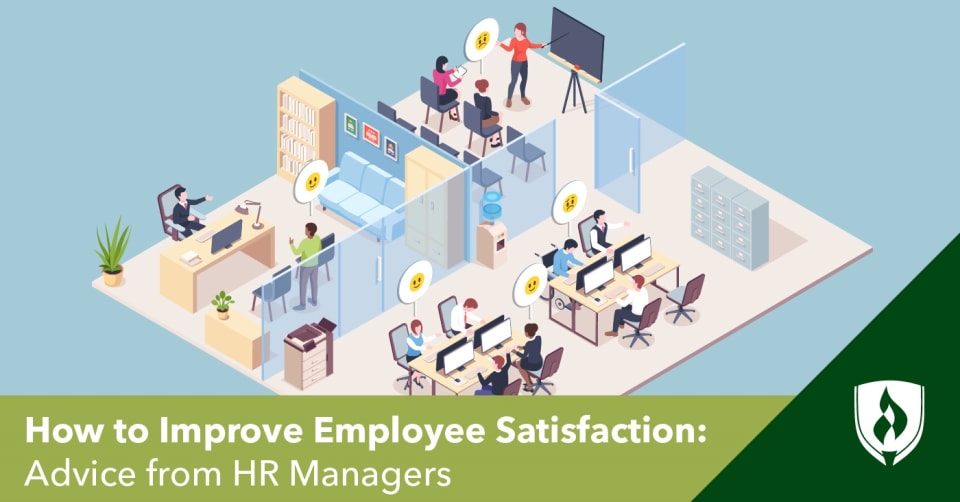
It’s a classic cliche: We can’t wait for the weekend because we all dislike our jobs so much. While the allure of the weekend is always going to be tough to beat—after all, there’s a reason you get paid to go to work—human resources (HR) pros know there’s plenty that can be done to make an employee’s time at work much more satisfying overall.
Ensuring employee satisfaction is an important part of many HR roles. Most companies don’t want to be known for having an unpleasant work environment that employees can’t stand. It’s not just a matter of public perception either. As we’ll soon see, high work satisfaction can benefit organizations in a number of ways.
It’s one thing to talk about increasing employee satisfaction, but it’s another to actually make this goal a reality. You may be wondering how to help your own HR department in its mission to foster a fulfilling workplace.
Look no further! We got the scoop from real-life HR managers on how to improve employee satisfaction in both the short and long term. Learn from their expert tips so that you can help your HR department take steps in the right direction.
The importance of employee satisfaction
Employee satisfaction goes beyond simply keeping workers happy, which is an emotion that no organization can create on demand. Instead, Gallup® reports that what employees really want is to be engaged with and inspired by their workplaces.1
“Satisfied employees are more motivated, engaged and committed,” says Clodagh Beaty, former HR manager and co-creator of the Emotional Salary Barometer. “Some of the many benefits include increased profits, productivity and sales, and decreased employee absenteeism.”
The data agrees. A 2016 Gallup report found that actively engaged employees show 10 percent higher customer ratings, 70 percent fewer safety incidents, 17 percent higher productivity and 21 percent greater profitability.2
10 Ways to improve employee satisfaction
1. Offer a competitive salary
While money isn’t everything, it’s a good starting point when you’re focused on employee retention and satisfaction. In a 2015 survey, employees rated pay the second-most important factor to their job satisfaction.3
These days, it’s relatively easy for employees to do their research and find out if they could earn more working for your competitors. Don’t give them a reason to go looking! Make sure that employee compensation is competitive and that there’s a clear system in place for promotions so employees never have to wonder when their next pay increase may be on the horizon.
2. Ask for employees’ suggestions
“Don’t make the mistake of assuming you know what will make your employees happy or failing to take into account the needs of different employee groups,” Beaty says. “The employee perspective will always be different from the HR or leadership perspective.”
The solution is simple: Ask employees to share their suggestions for positive change. This is also a good place to gauge how satisfied employees currently are with their work. There are plenty of tools and surveys available that can help you gather ideas from employees quickly and easily. While not every suggestion may be feasible, this approach will at least give your organization a better handle on what is promoting—or driving down—overall employee satisfaction.
3. Be transparent
What you do with your employees’ feedback matters just as much as gathering suggestions in the first place. Taking an employee survey will seem performative if employees don’t see any of their ideas being put into place.
Beaty recommends focusing on action steps you can take to get started implementing changes and keeping employees in the loop throughout the process. “It is important to make it a continuous process with open and transparent communication on both sides.” This shows employees that you value their suggestions.
4. Get creative with benefits
Employee benefits are an often-overlooked aspect of the compensation package that can make a big difference in job satisfaction. For example, 67 percent of organizations haven’t made any changes to their family-friendly or wellness benefits in the past year, despite the fact that they’re relatively low-cost to implement and receive a lot of enthusiasm from employees.4
“When you invest in your employees’ healthcare plans, retirement packages and family-friendly benefits, they feel like you care,” says Anjela Mangrum, president of Mangrum Career Solutions. These are just a few creative benefits ideas that can help you stand out from other organizations and boost employee satisfaction:
- Subsidized childcare or elder care
- Options to bring your child to work if your original childcare falls through
- Free credit counseling services
- Onsite yoga or meditation
- Paid time off for volunteering
5. Listen to employee concerns
Employees may have genuine concerns about the culture of your workplace, but they are unlikely to share them with management if they fear repercussions. Help employees feel more comfortable with voicing problems by making it clear that you’re not there to punish them.
“Ensure that managers are having regular conversations or one-on-one meetings if at all possible,” says Pamela Ilieva, head of HR at Shortlister. Scheduling regular meetings where employees have the opportunity to be honest in a confidential setting can make it less awkward for employees to bring to light any areas where the work culture needs improvement.
6. Celebrate successes
It might seem like a little thing, but a whopping 94 percent of employees who receive positive recognition on a daily basis reported being satisfied or very satisfied with their jobs.3 Celebrating accomplishments for both individuals and teams can clearly have a big impact on work satisfaction.
Set aside regular opportunities to celebrate big wins as a whole department or organization. Leave space in meetings for people to share their own or others’ most recent achievements. Even writing a thank you note, sending a quick email of congratulations or stopping by someone’s desk for a high-five makes employees feel seen and valued.
7. Prioritize mental and physical well-being
It’s difficult to feel satisfied at work when you’re not at full health, whether that’s mentally, physically or emotionally. One study found that the link between life satisfaction, including health and work satisfaction, is reciprocal; you can’t have one without the other.5
Unfortunately, many organizations have a culture of workaholism that contributes to stress, burnout and declining employee health. “Instead of lauding your ‘hard workers’ who never seem to leave the office, appreciate those who get things done on time and within office hours,” Mangrum says.
8. Invest in employees’ future
Some employees look for other job opportunities simply because they aren’t sure how to advance their career in their current organization. “Building a clear job path structure and making it transparent for employees can help reduce this churn,” Ilieva says.
Make a point of talking with employees one-on-one about their future career goals and what the expectations are for them to achieve these goals at your company. Offer opportunities for them to increase their skills, such as sending them to a conference or giving them projects that will stretch their experiences.
9. Don’t forget remote employees
The growth of remote work has posed a unique challenge for organizations who have had to pivot to make sure their teams still feel connected and able to voice any concerns. The Slack reports nearly 85 percent of employees want to feel more connected to their remote coworkers.6
If you have remote employees on your workforce, don’t forget that all of the above tips apply to them too. You can go the extra mile by scheduling regular one-on-one feedback sessions, hosting virtual team game nights or offering a stipend for memberships to at-home exercise programs.
Unlock increased employee satisfaction
There’s no secret formula to boost employee satisfaction, but this tried-and-true advice will give you a place to start. It takes a dedicated effort from leadership on down to shift employee satisfaction and attitudes.
Are you energized by the idea of leading the charge to shape a workplace culture? Perhaps you have a future in human resources leadership. If so, earning a Master’s degree can be excellent way to prepare yourself for leadership roles in this field. Want to think it over? Our article “Why Earn a Human Resources Master’s Degree? 6 Reasons to Consider” can help provide some additional food for thought.
1Jim Harter and Annamarie Mann “The Right Culture: Not Just About Employee Satisfaction,” Gallup, April 12, 2017 [accessed April 2021], https://www.gallup.com/workplace/236366/right-culture-not-employee-satisfaction.aspx
2Marko Nink and Jennifer Robison “The Damage Inflicted by Poor Managers,” Gallup, December 20, 2016 [accessed April 2021], https://news.gallup.com/businessjournal/200108/damage-inflicted-poor-managers.aspx
3Stephen Miller, “Better Pay and Benefits Loom Large in Job Satisfaction,” The Society for Human Resource Management (SHRM), [accessed April 2021], https://www.shrm.org/resourcesandtools/hr-topics/compensation/pages/pay-benefits-satisfaction.aspx
4“Family-Friendly and Wellness: SHRM 2019 Employee Benefits,” The Society for Human Resource Management (SHRM), June 2019 [accessed April 2021], https://shrm.org/hr-today/trends-and-forecasting/research-and-surveys/Pages/Benefits19.aspx
5Dorota Weziak-Bialowolska, Piotr Bialowski, Pier Luigi Sacco, Tyler VanderWeele and Eileen McNeely “Well-Being in Life and Well-Being at Work: Which Comes First?” Frontiers in Public Health 8, 103, April 9, 2020 [accessed April 2021], https://www.ncbi.nlm.nih.gov/pmc/articles/PMC7160299/
6”Trust, Tools and Teamwork: What Workers Want” Slack, October 3, 2018 [information accessed April 2021] https://slack.com/blog/transformation/trust-tools-and-teamwork-what-workers-want
Gallup is a registered trademark of Gallup, Inc.




